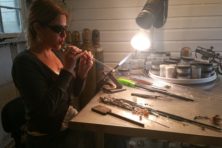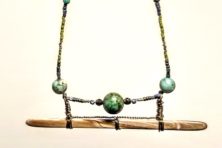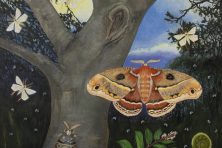An Infusion of Creativity and Skill: Turtle Ridge Studio Gallery
- Share
- Tweet
- Pin
- Share
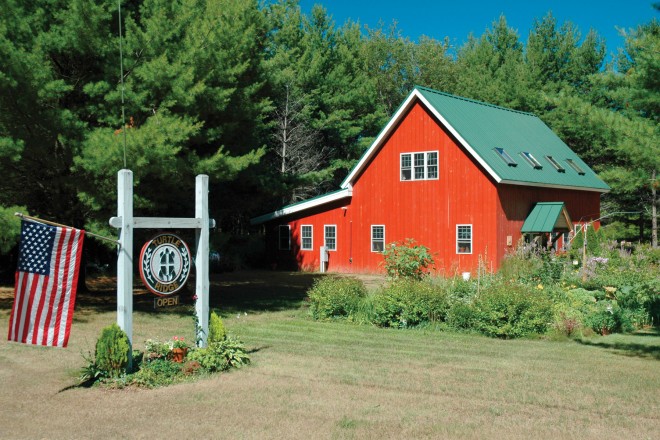
It occurred to me after my visit with Turtle Ridge owner Mary Ellen Sisulak that, apart from the occasional tapestry, fabric as an artistic medium has never really been on my radar. Subconsciously I’ve regarded the stuff of fabric – clothing, scarves and bags – as little more than the dolled-up daughters of necessity: fashionable, sure, but foremost functional.
I’ve also never thought much about the people who construe fabric into these items. My closet abounds with anonymously woven and sewn garments. Even hearing famous names like Calvin Klein and Donna Karan fails to conjure an image of someone furiously scribbling, measuring and stitching and, more, that they might consider themselves artists in the truest sense. Instead I picture Amazon-tall models strutting precariously down camera-flanked runways; little connection seems to exist between the items on these glamorous people and their makers.
Discovering such a connection is just one of the reasons my trip to Turtle Ridge was so enlightening. Mary Ellen is one of those people who scribbles and stitches for a living, and she does so with both dexterity and a discerning eye. Her Ellison Bay studio is an ambient, sky-lit mini-factory complete with clunky machines, large swatches and rolls of fabric, and dozens of boxes and bins full of thread, zippers, snaps, rivets and all of the little things she uses to construct (primarily though not exclusively) fine leather handbags and purses.
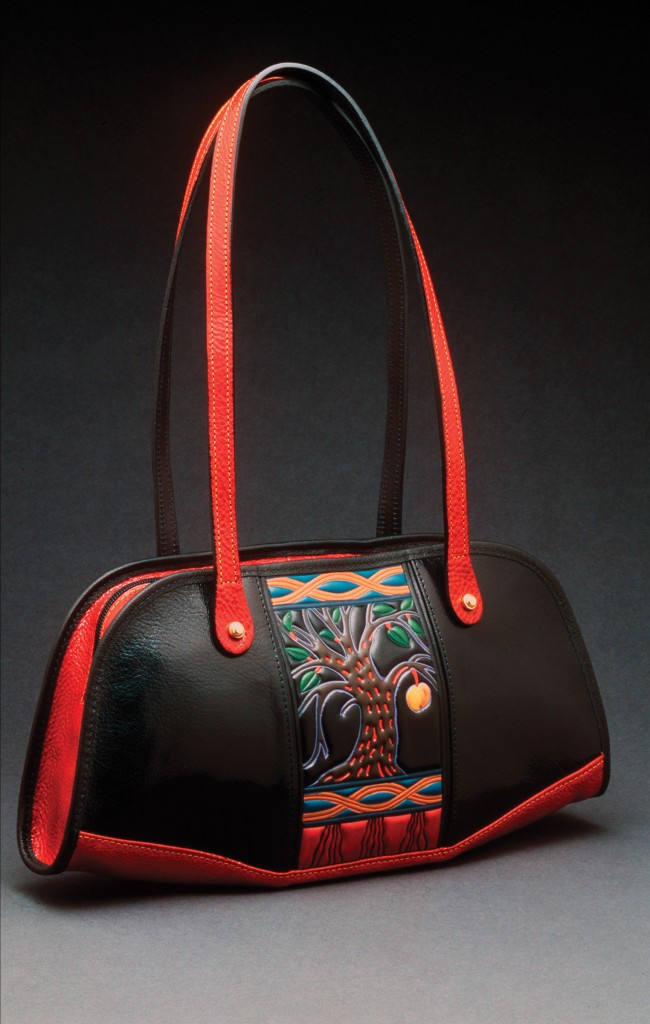
I admit being caught off guard by not only the complexity of the start-to-finish process but also the expressiveness of her products. According to Mary Ellen, the process begins with a Guache painting on paper. The paintings are inspired by the gardens on her serene Mink River Road property, the acres of Nature Conservancy land adjacent to her own, and her travels to Mexico and elsewhere; and they typically depict frogs, birds, plant life or, as one would expect, turtles.
Once Mary Ellen selects a finished painting, she then sets to the task of readying the painting to be made into an embossing plate. “I reduce the paintings to the simplest form I can that will emboss,” says Mary Ellen, “and I decide on the colors and the details.” Embossing plate in hand, she then places it, along with a dampened piece of leather, into a giant hydraulic dye press that will exert 16 tons of pressure, thus stamping an indelible pattern into the fabric. After this is complete, says Mary Ellen, “I let the leather dry, then hand-paint it and put a seal on it.” Ultimately, this leather patch will become the centerpiece of a Sisulak bag and will lend an unmistakable signature quality to the finished product.
Meanwhile, the design and engineering of the bag itself must be done. First a pattern is made on graph paper, then a few prototypes are created and tested, revisions are made, and the resulting shapes are made into forged dyes, or polygonal and curved metal shapes that “cut the leather like a cookie cutter,” also on the hydraulic press. Once the leather pieces are produced, often 20 or more for a single bag, they must be “skived” before assembly. Skiving is performed on a small machine (resembling a sewing machine) that more or less shaves the edges of the leather along the perimeter to allow the leather to be easily folded before it is finally sewn together.
The leather itself is another science altogether. “The leather we use comes from five different places and it’s all domestic hide,” says Mary Ellen. “Cow hide is the brunt of what we use, but we also use sheep, goat, pig, and buffalo. Each animal’s hide has its own grain texture. Goat hide, for example, is a tighter texture with smaller cells, whereas pig hide is very thin and is great for lining. I also like to use vegetable tan leather which has a gorgeous patina and comes in many colors. And we only want fine leather – we’re picky!”

As she explains the process, it becomes clear that each step – from painting on paper to attaching the last touch, a small turtle medallion for the zipper’s pull – requires an infusion of creativity and skill. The resulting handbags are a far cry from their mass-produced cousins found everywhere; rather, they are art forms, well-crafted and built to last.
It is clear, too, that Mary Ellen’s personality is manifested in her work. As an artist, there is something Zen about her that perhaps comes from her connection to nature, and is clearly evident in the smooth lines and carefully pondered details of her handbags and purses. The name “Turtle Ridge” even speaks to this character trait: “We [Mary Ellen and husband Robert] saw a painted turtle on the property when we bought it in 1978. Turtles are a good symbol with legends in every culture. They mean honesty, patience, perseverance – it’s been a talisman for us.”
Presence of a talisman or not, Mary Ellen has also proven a capable and hardworking businesswoman. In addition to running the studio and the on-site gallery, she also attends about 12 wholesale and retail shows annually across the country. Winters are spent creating new designs and getting a head start on production for those shows, while summers bring the usual busyness of a seasonal economy. With a hint of regret, Mary Ellen also tells me about the two or more days a week she spends just keeping up with office work. “Taxes, payroll, ordering, applying to shows, advertising, accounting, doing mailings for shows – it’s unbelievable how much paperwork there is even with a small business like this.”
Luckily, however, she has some help. Kim Kolstad has worked with Mary Ellen in the studio for five years and takes care of the wholesale sewing for the smaller product lines in addition to, as Mary Ellen says, “sharing the responsibility of waiting on customers and giving tours.” Additionally, Asta Zukauskiene, who works outside the studio as a subcontractor, has been doing piecework production sewing on fiber for about 15 years, and Jane Ama, also a subcontractor, has painted all of the embossed designs for about 12 years. Even Mary Ellen’s father helped earlier on for about 10 years “making the sheet metal pattern pieces from recycled materials [using] odds and ends from air conditioning and heating duct work.”
And of course there is Robert, her husband, a builder who for about five or six years worked in the gallery alongside Mary Ellen to develop it as a year-round business. He now assists in all sorts of ways, including attending shows. He even built the studio not once but twice after it burned in 1996 – an event which evokes praise and thanks for the community from Mary Ellen. “People helped us rebuild in many ways, including monetarily. It was an affirmation of the greatness of Door County. When the chips are down, you can count on the people here.”

As for Mary Ellen’s thoughts on her chosen career, she seems especially willing to continue down the road she’s on. “I’m lucky,” she relates. “I get to do all kinds of different things, grow as an artist, I get to go to wonderful places, and work in a wonderful place. I have a great family that’s supportive and wonderful employees. I love that people really appreciate what I do, too, and they validate my work by buying it. Of course there’s the down side that you can’t depend on anything but your own two hands – and that can be scary – but most self-employed people have those worries. You just deal with it.”
If Mary Ellen is correct that the key to success is depending on one’s own two hands, it’s an easy contention that she has nothing to worry about. And if success is measured by the gifts of one’s artistry, then she is especially well-poised for prosperity – Mary Ellen has accomplished much more than simply defining the point where function and fashion meet, she also has the enviable ability to breathe soul into everyday material items, rendering them the most unexpected and multifaceted of art forms.


